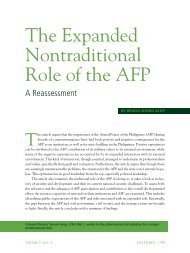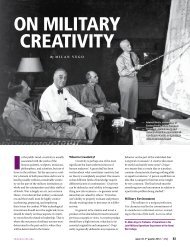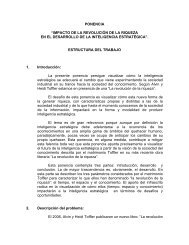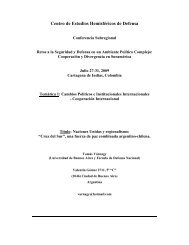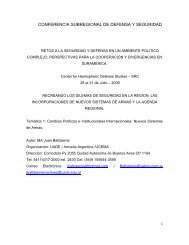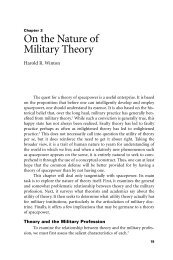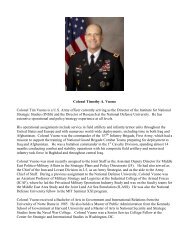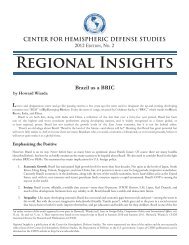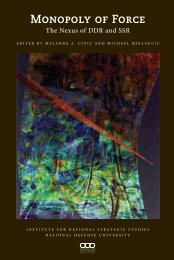In the second half of the 20th century, the US enjoyed pre-eminence ...
In the second half of the 20th century, the US enjoyed pre-eminence ...
In the second half of the 20th century, the US enjoyed pre-eminence ...
You also want an ePaper? Increase the reach of your titles
YUMPU automatically turns print PDFs into web optimized ePapers that Google loves.
Executive Summary<br />
<strong>In</strong> <strong>the</strong> <strong>second</strong> <strong>half</strong> <strong>of</strong> <strong>the</strong> <strong>20th</strong> <strong>century</strong>, <strong>the</strong> United States <strong>enjoyed</strong> stature and prosperity at levels<br />
seldom achieved in recorded history. The country’s status included <strong>pre</strong>dominance in most fields<br />
<strong>of</strong> science and technology (S&T), as well as a phenomenal breadth and pace <strong>of</strong> innovation. We<br />
are now experiencing a global shift to a more level playing field among nations; demographics,<br />
economics, and political forces are <strong>the</strong> driving forces behind this shift. The impact <strong>of</strong> this shift on<br />
U.S. S&T will be significant. By <strong>the</strong> middle <strong>of</strong> <strong>the</strong> 21st <strong>century</strong>, it is likely that a number <strong>of</strong><br />
nations will be similarly prosperous and technologically productive. No single nation or group<br />
will dominate as <strong>the</strong> United States did in <strong>the</strong> latter <strong>half</strong> <strong>of</strong> <strong>the</strong> 1900s. The U.S. share <strong>of</strong> <strong>the</strong> global<br />
S&T enterprise will decrease, and only a small fraction <strong>of</strong> U.S. scientists and engineers (S&E)<br />
will work on national security problems. This change poses challenges to <strong>the</strong> roles and conduct<br />
<strong>of</strong> Department <strong>of</strong> Defense (DOD) S&T. <strong>In</strong> particular, DOD’s ability to maintain an authoritative<br />
awareness <strong>of</strong> S&T developments around <strong>the</strong> world will become increasingly problematic.<br />
Most attempts to quantify <strong>the</strong>se challenges utilize simple linear or exponential extrapolations.<br />
Although such approaches are helpful for short-term <strong>pre</strong>dictions, <strong>the</strong>y tend to produce<br />
unrealistically pessimistic <strong>pre</strong>dictions for <strong>the</strong> timescales considered in this paper. The <strong>pre</strong>sent<br />
work establishes an empirical relationship between an economy’s gross domestic product (GDP)<br />
per capita and its ability to generate S&T knowledge. This paper <strong>the</strong>n employs <strong>the</strong> results <strong>of</strong> a<br />
full economic analysis for <strong>the</strong> period 2005–2050 to estimate <strong>the</strong> S&T knowledge production for<br />
each <strong>of</strong> <strong>the</strong> world’s 17 largest economies.<br />
The estimate indicates that U.S. share <strong>of</strong> S&T productivity will decline from about 26 percent in<br />
2005 to 18 percent in 2050. This decline, while problematic, is not unmanageable. At least<br />
through 2050, <strong>the</strong> United States will remain one <strong>of</strong> <strong>the</strong> world’s most significant contributors to<br />
scientific knowledge. As a result, <strong>the</strong> U.S. S&T workforce should be large enough, relative to <strong>the</strong><br />
world S&T workforce, to remain cognizant <strong>of</strong> S&T developments around <strong>the</strong> world—although<br />
<strong>the</strong> means <strong>of</strong> doing so may change. This ability to remain cognizant is important because by<br />
2050, countries o<strong>the</strong>r than <strong>the</strong> United States will produce most scientific knowledge. Maintaining<br />
an authoritative awareness <strong>of</strong> S&T around <strong>the</strong> world will be essential if <strong>the</strong> United States is to<br />
remain economically and militarily competitive. This awareness includes <strong>the</strong> ability <strong>of</strong> <strong>the</strong> U.S.<br />
S&T workforce to authoritatively inter<strong>pre</strong>t trends in global S&T. For instance, <strong>the</strong> U.S. S&T<br />
workforce must be able to quickly recognize movements in <strong>the</strong> frontiers <strong>of</strong> knowledge and <strong>the</strong><br />
potential for new military applications stemming from new knowledge or a combination <strong>of</strong><br />
existing knowledge and new technology. The required awareness can be maintained only if <strong>the</strong><br />
U.S. S&T workforce is a participant in <strong>the</strong> global S&T community. This is true for <strong>the</strong> DOD<br />
S&T workforce as well.<br />
For DOD to succeed, it will be necessary to find a means to tap <strong>the</strong> knowledge <strong>of</strong> <strong>the</strong> larger U.S.<br />
S&T community regarding global S&T. It is only at this level that <strong>the</strong> United States will have a<br />
sufficient number <strong>of</strong> S&T “brain cells” to actually know what is occurring in <strong>the</strong> world <strong>of</strong> global<br />
S&T, what is important, and what is not important. Tapping this knowledge will be very<br />
challenging for DOD. Never<strong>the</strong>less, we must ensure <strong>the</strong> global S&T knowledge held by <strong>the</strong><br />
larger U.S. S&T community is available to <strong>the</strong> military and that DOD has <strong>the</strong> internal capability<br />
to com<strong>pre</strong>hend and exploit this knowledge through <strong>the</strong> DOD S&T workforce. The term “DOD<br />
S&T workforce” refers to those S&Es who are funded by DOD S&T dollars that fall into <strong>the</strong><br />
1



